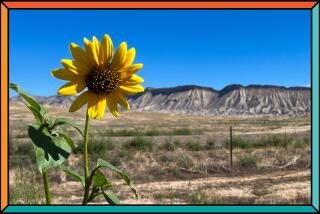Arizona sightseeing--a lot of desert, history and an enormous crater . . . but, oh for a schooner of suds!
Arizona proves what a lack of rain can do for a country. It is magnificent in its aridity. Passing through this vast desert by automobile on a good highway, one marvels that the Indians could have coaxed a living from its rocky soil for millennia; that the pioneers could have crossed its waste; that the conquistadors could have plodded across it, driven by greed and Christian missionary zeal, all the way to Santa Fe.
After leaving Phoenix we drove through Flagstaff, which has retained its character as a lumber town, and then on Interstate Highway 40 toward Albuquerque.
For hours we drove through low sculptured red mountains and buttes. My wife had never seen the Southwest, but it was familiar to her from a hundred Western movies. We had seen wagon trains traversing this wasteland, and troops of the 6th Cavalry led by an intrepid John Wayne. Apaches had looked down on us from these mesas. It looked like one vast, improbable movie set.
A small sign said that a meteor crater was off to the right. I took the road. It led five miles to a cluster of buildings on a slope of upthrust earth. We walked through a souvenir shop and paid $2 each to see the crater.
I had read about the crater, and I wanted to see it, because it seemed to me to be a reminder that chance rules our destinies. If such a meteorite had hit the earth once, why couldn’t it happen again, at any moment, say at Hollywood and Vine?
We looked down on it from a catwalk. It was an awesome hole in the ground. A leaflet told us that the meteorite had struck the earth 30,000 years ago; that would have been before the Indians came. It was made of nickel and iron and was traveling at 43,000 miles an hour. When it struck it blasted out 300 million tons of rock, making a crater 60 stories deep, 4,100 feet in diameter and three miles around.
I thought an interesting illustration of its size was the statement that it could accommodate 20 football games simultaneously, and 2 million spectators could watch from its sloping sides. What a Super Bowl that would be!
When the crater was first reported by white men in 1871 it was thought to be an extinct volcano. The notion that it had been caused by a meteorite was dismissed by a geologist after a brief study in 1891. In 1903 Daniel Moreau Barringer, a Philadelphia mining engineer, became convinced that the hole had been dug by a giant metal mass, and he assumed that this object lay beneath its center. He began digging. He dug for 25 years and died disappointed. (Most of the meteorite was vaporized on impact.) But Barringer proved the cause of the crater, even though, like so many prospectors in the desert, he found no riches.
Later, on the horizon to our north, we saw the famous Painted Desert, rock formations of gorgeous pastel strata. It verified the old metaphor of the Great Painter and his color box.
Near the New Mexican border the red buttes became ever more prominent and closer to us. Some had eroded figures on top like Henry Moore sculptures. One looked like an Indian man with a woman squatting at his side.
It is an irony of civilization that such gorgeous scenery should be the gateway to Gallup, N.M., certainly one of the least pleasing towns on the face of the earth.
Like so many small towns in America it has grown along a strip of motels and fast-food joints. It is spread out along the railroad track which gave it its reason for being. The old part of town, toward the east, seemed to be mostly beer joints, liquor stores and pawn shops.
We stopped at a clean-looking motel and after I registered I asked the manager, “Where can we find a beer around here?” It had been a long thirsty day.
He said, “You’ll have to go to the next county. Gallup’s dry on Sunday night.”
From the righteous tone of his voice I gathered that it pleased him to tell me that. I put him down for what the Australians call a wowser--a person who is against anything that gives anyone else pleasure.
I could hardly believe it. I hadn’t actually been in a dry town since a Navy DC-3 I was flying to Pensacola in, back in the 1950s, made an emergency landing in Waco, Tex.
We found a Mexican restaurant and dined on green chili stew and diet Pepsi. A frugal, sober meal.
The next day we drove on through the magnificent New Mexico desert toward Albuquerque. Somehow the freight trains didn’t mar the landscape. They seemed to be a part of it. We could see them a mile or two away, four or five engines and more than a hundred cars, inching along like pretty snakes. They had been doing this for more than 100 years.
As we approached Albuquerque, billboards began to appear beside the highway. There were hundreds of them, advertising motels, eating places and Indian jewelry stores. It was a desecration. I wondered why a state that provided such good highway signs and roadside rest areas should permit such wanton despoliation of its matchless natural beauty by billboards.
The answer is obvious. God gave us the desert. He gave us California, with our variegated scenery.
He also gave us the outdoor advertising industry, and dry Sundays in Gallup.
More to Read
Sign up for The Wild
We’ll help you find the best places to hike, bike and run, as well as the perfect silent spots for meditation and yoga.
You may occasionally receive promotional content from the Los Angeles Times.






